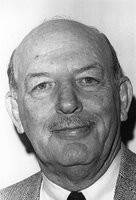
August 21 was Friz Freleng's birthday and many blogs celebrated with material relating to Friz. Unfortunately, I was too busy to participate. However, I do have some letters from Friz regarding his time at MGM for the article I once wrote on that studio's cartoon history. Here's one of them:
February 24, 1976
Dear Mark:
My apologies for the long delay in answering your letter of the 3rd. I have been so involved in development for the new season, I have been unable to give your letter its deserving time.
I will have to admit that your information of me is more accurate than my own. I did not recall the picture titles of the M-G-M series until you mentioned them. (I am sorry that my memory does not serve me better.) Ther were a few other cartoons that I directed at M-G-M that I can recall, such as "The Mad Maestro" and "The Bookworm." (These were in color and under the Hugh Harman banner.)
I went to M-G-M after I was tempted by Fred Quimby through flattery of my work at Warners', and an increase to almost double of what I was earning at Warner Bros. Of course, afer I had committed myself to M-G-M, Leon Schlesinger offered me more to stay at Warners', but he was too late with his offer. I was committed to M-G-M in August, but my contract with Schlesinger expired in October 1939. [Mayerson here. I believe that Freleng got the year wrong and it should be 1937.]
During the period from August to October, M-G-M's top brass bought the rights to "Captain And The Kids." I balked at making these characters into an animated series and expressed myself thusly, but to no avail. M-G-M said they were dedicated to making good cartoons, and they thought that this being printed in so many papers would make it a popular cartoon. I was forced to prove them wrong.
Even though the M-G-M budgets were twice as much as Schlesingers, the creative freedom was lacking, and I knew I had made a mistake in leaving Warners'. When my contract expired, Schlesinger sent his manager over to see me and asked me to return. (Secretly I was more than happy to.) Quimby then went after Leon's second director, Tex Avery, who stayed with M-G-M until the studio closed. [Mayerson here. Avery definitely was gone to the Lantz studio before M-G-M shut down.]
I never regret the experience at M-G-M, but the politics under Quimby was unbelievable. I did not have the ability to cope with it.
After my return to the Schlesinger stable, I earned five Oscars for the studio. I supposed the experience away from Schlesinger gave me a new perspective, looking back now.
I stayed with Warners' until it closed, then David DePatie and I formed a partnership and took over the cartoon studio in 1963. We produced cartoons for United Artists, and when Warners' wanted more cartoons, we produced "Road Runner" cartoons and "Pink Panthers" at the same time.
When Warners' decided they wanted us exclusively, we balked at the idea, and they gave us a choice - Warner cartoons or the Pink Panthers. We chose Pink Panther. The result was, we were forced off of the Warner lot and had to build our own studio. Warners' then threw in the sponge and gaveup the cartoons permanently.
Enclosed is a photo that I hope will fill your requirements.
Best to you.
Sincerely,
Friz Freleng.



3 comments:
Thanks, for sharing this Mark. MGM is probably my favorite studio. Or at least their cartoons are my among my very favorites and it's very interesting to read Friz' reasons for leaving the studio directly from him. It's a shame they tried to cram the "Captain and the Kids" down his throat. I would've liked to have seen what his cartoons would've been like with those large MGM budgets.
Oh, I forgot to ask. Have you ever posted that article about MGM? What magazine was it in?
Hi Kevin. The article was in a film journal called The Velvet Light Trap, published out of the University of Wisconsin. It was in issue #18. I'm not going to reprint the article because I think there's better information that's been published since the article appeared in the '70's.
The best thing about the article was the letters that I got from various animators. I'll be printing them in full on this blog, so if you keep watching you'll eventually see them all.
Post a Comment